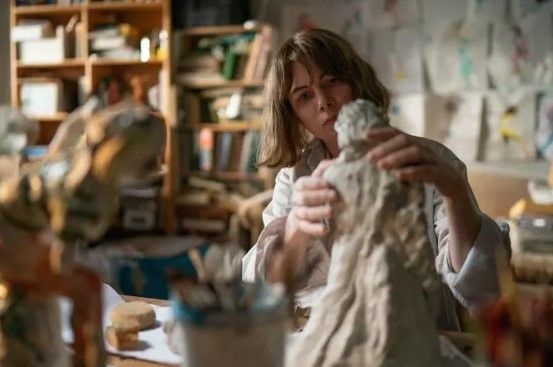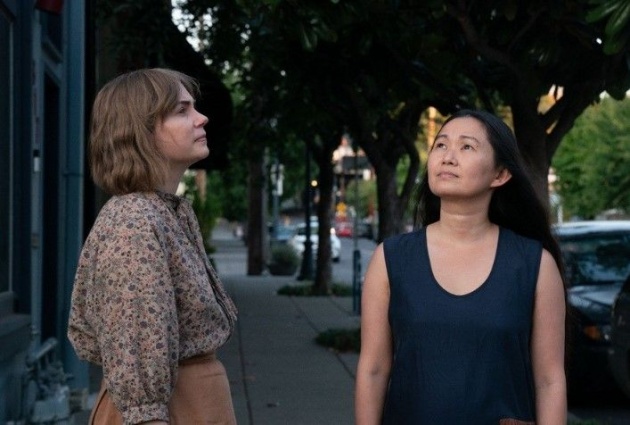
Pictured: Pinch points. Sculptor Lizzy (Michelle Williams) at work in a scene from the comedy-drama, 'Showing Up', co-written and directed by Kelly Reichardt. Still courtesy of A24 Films (US)
The phrase ‘showing up’ has multiple connotations. You can show up unannounced – uninvited and imposing. Your reluctant host eagerly anticipates your departure. Showing up also means humiliation, casting shade. You might be competent but someone in the room grabs the attention, letting off fireworks. Moreover, they get a catalogue. Your relatives can show you up too, behaving in your presence in such a way that you become responsible for their actions, or at least you feel that way. You show up for work, but are you really there? Presenteeism is a problem, colleagues being reluctant to do admin. Showing up can also be a good thing. The person you thought who was lost finally appears. Does it really matter if they eat all the cheese? A friend can show up; their timely intervention can put everything into perspective. Director Kelly Reichardt explores all of these meanings in her seemingly low-stakes drama, Showing Up, which she co-wrote with her frequent writing partner Jon Raymond. It is a film that doesn’t so much grab your attention as ease its way in gradually. It reminds you that your closest friends are frequently not the people you gravitated towards instantly, rather those you get to know slowly, who reveal themselves to you in select moments.
Reichardt is a true auteur, a filmmaker with a distinct style who doesn’t waver in the face of commercial pressure. Her work is intimate, compassionate towards her characters, but also outside them. You might judge a person by their story, but Reichardt doesn’t give you that. She shows you behaviour instead. In fact, Reichardt doesn’t allow you to fully form an opinion of her protagonists – the antithesis of commercial cinema convention. You relate to them – and that finally is enough.
The credit sequence is alluring, moving between water colour sketches of figurines that the film’s protagonist, Lizzy (Michelle Williams) will pinch and mould in plaster. In the film’s nominal ‘oner’ (single take), Reichardt’s camera accentuates the rough and unready, occasionally doubling back and zooming slightly to improve the framing. Lizzy’s sculptures of women – or more accurately the same woman in different poses, in one piece bending down, in another leaping – are not decorative. They are imperfect, sometimes incomplete. To isolate a woman, with context provided only by clothing and body position, is to suggest possibility and alternate sources of joy, not derived from being a wife or mother. The colouring is selective too, suggesting mood. The detail is both naturalistic (in the faces and body shape) and expressionistic, using artifice to suggest a woman’s rough edges in the absence of speech and setting. In short, Lizzy’s work deserves a catalogue.
Reichardt’s one forgivable trope is that Lizzy has a cat; the woman living alone naturally needs a companion, and the cat needs to be fed. At no point in the film is Lizzy positioned as the object of desire. She wears a sweatshirt that conceals her figure; Williams, who once played Marilyn Monroe in a film, is transformed. Lizzy does have a problem – no hot water. She cannot take a shower in her own home. Her landlady, Jo (Hong Chau) is responsible. When we first meet Jo, she is pushing a tyre along the sidewalk with the speed and enthusiasm of a child playing with a new toy. Reichardt follows Jo into her yard. We see Jo with a piece of rope that she forms into a noose. This is a film about artists, and we immediately fear the worst. But Jo isn’t about to hang herself. She is making a swing, something she always wanted. Like Lizzy, Jo too is an artist and wears utilitarian clothes. Jo looks forward to the pleasure of her creation and has two shows opening at the same time. (‘I love how the two shows talk to each other,’ she brags in pretentious artist speak.) Lizzy is less than enthusiastic about her own pieces.
Lizzy works as administrator in an arts centre – the film was shot on the premises of the (now closed) Oregon College of Art and Craft, though the location is never mentioned. Her boss is also her mother, Jean (Maryann Plunkett). To say that Lizzy is unenthusiastic about her work is an understatement. Given a set of receipts to process (for artists’ expenses, including those paid by an employee in cash), Lizzy passes them to an intern. A job can be a reminder of the success you haven’t experienced. We intuit that Lizzy only has a job because of her mother, though her work as a sculptor is respected. Lizzy is preparing for a show which – no spoiler really – forms the film’s climax. She is contrasted with one of the centre’s tutors, Eric (André Benjamin, who also contributes flute music to the film’s soundtrack). He radiates selfless encouragement. A young woman presents to him her multi-coloured knitted creation – woollen dungarees. She solved the issue with fastening by using Velcro, which she tells Eric that she knows isn’t the ideal solution. Eric responds enthusiastically. One of the cliches about artists is that they seek the glow of approbation, which in turn drives their work. The least satisfying type of artist is one who shares their work too early, gets a welcoming response then never completes it, having already achieved their objective.
We admire the work being done at the centre. One piece is a multi-coloured woollen web, which is the opposite of what a spider would wish to spin. The point of a web is for an insect only to be aware of it once trapped inside; a multi-coloured web does not have entrapment as its aim, which perhaps makes it more glorious, since entrapment is a bad thing. A multi-coloured spider’s web is also a luxury, since spiders rely on their webs for survival.
Lizzy visits her father Bill (Judd Hirsch) who is hosting two ‘spongers’ (Lizzy’s word), Lee (Matt Malloy) and Dorothy (Amanda Plummer). When we first meet them, they are each stretched out barefoot on Bill’s two couches – the human equivalent of cats. Bill describes them as spending their time between two countries, relying on the kindness – or the manners – of others. It is their bare feet that are the most offensive; a proprietorial gesture that also says, ‘wait upon me’. You don’t expect people in bare feet to prepare their own meals, dirtying their feet on the floor. Looking at her father’s ceramic collection – it is implied that he inspired her to be an artist - Lizzy encourages him to create again. Bill is happy with his retirement. His days are full. Lizzy resents that strangers have imposed upon him. The implication is: what will be left for Lizzy and her brother Sean (John Magaro)?
Reichardt shows Lizzy at work, attaching an arm to a figure or pinching clay. We don’t see the work through her eyes, that is, with a full sense of what she is creating. Reichardt doesn’t want art to be judged by the artist’s intention rather than by what the work says to the individual exposed to it. The result is that the scenes of creation are without tension, though there are moments of drama when the sculptures emerge baked from the centre’s oven. Five sculptures in one batch are perfect; one sculpture baked on its own exhibits a nasty black stain.
Reichardt is unhurried arriving at the point of drama – a pigeon that flies into Lizzy’s home and is attacked by her cat. She decides to nurse it back to health, though Jo – forever stimulated by events but not by the prospect of getting Lizzy’s hot water fixed – also shares the responsibility. The pigeon becomes the subject of a micro-aggressive wrestling match to prove who is the better person. At one point, Lizzy brings the pigeon to a vet, who is unwilling to perform surgery, suggesting instead to keep it warm. The consultation costs $150. ‘Hey, Lizzy paid $150 to take a pigeon to a vet,’ a co-worker shouts after hearing the news. Pigeons are a species that are not kept as pets; they are the multitude with whom we live alongside, barely acknowledged, though sometimes shot at. They are certainly not domesticated. It is another way in which she demonstrates that she is like her father, who also looks after the uncared for. When Lizzy tells Jo about the fee, Jo replies, ‘take it off the rent’.
Tension between Lizzy and Jo steadily grows, after Lizzy approaches the centre to allow her to take a shower. ‘You’re not supposed to be here,’ a security guard chides her. It explodes when Jo has a party. Lizzy shouts out of her window in frustration and later leaves an angry answerphone message. ‘You’re getting a good rate,’ Jo tells her by way of defence, referring to the rent being charged. In other words, your living costs are subsidised, so back off.

Pictured: Artists Lizzy (Michelle Williams) and Jo (Hong Chau) in a scene from the Oregon-set comedy-drama, 'Showing Up', co-written and directed by Kelly Reichardt. Still courtesy of A24 Films (US)
Lizzy visits Sean, who is even more disturbed than she is. We suspect that he doesn’t live nearby, otherwise Lizzy would use his shower. We see him digging a hole in his backyard. ‘What are you doing?’ asks Lizzy. ‘What do you think I’m doing?’ Sean snaps back. ‘I’m making a piece. A very major piece.’ ‘I didn’t know you did earthwork,’ Lizzy responds, trying to take the bite out of the conversation. Lizzy invites Sean to her show. There is to-and-fro about a written invitation (Lizzy didn’t send one). ‘This is your invitation,’ she says. Sean promises to be there, though his instability is palpable. Digging appears to be a form of anger management.
The slow-baked drama finally rises at the opening in which the entire cast appears. There is a conversation between Lizzy’s parents about an artist who Bill criticizes. ‘You didn’t know her,’ says Jean. Lee and Dorothy are there, keen to graze rather than to appreciate the art. The pigeon in its bandage, its wings unable to flap, is placed at one end of the gallery, away from the cheese. Sean isn’t there. A visit to his house makes his family fear the worst. Cheese consumption becomes a point of contention. Then some children attend to the pigeon, prompting a disturbance. Reader, I feared the worst, with all that vulnerable art in the room.
How is the drama resolved? The pigeon becomes a metaphor for art itself, released into the world, surviving on its merit. It also is a metaphor for a source of tension, suddenly gone. Reichardt ends the film with two women walking off into the distance, the ultimate Bechdel Test three-cherry score. Not only does art leave them behind – they put some distance between themselves and creativity. People make art ultimately to connect. So connect already!
Reviewed at Rialto Cinema, Screen Five, Nice, France, Sunday 21 May 2023, 16:10 screening



